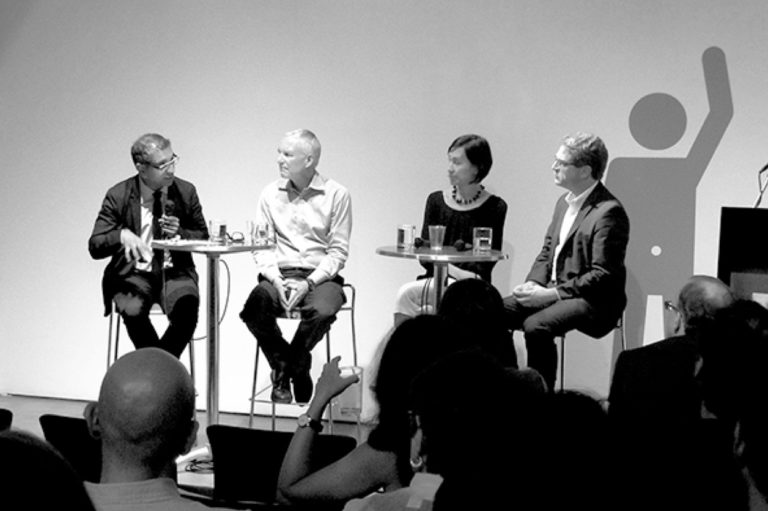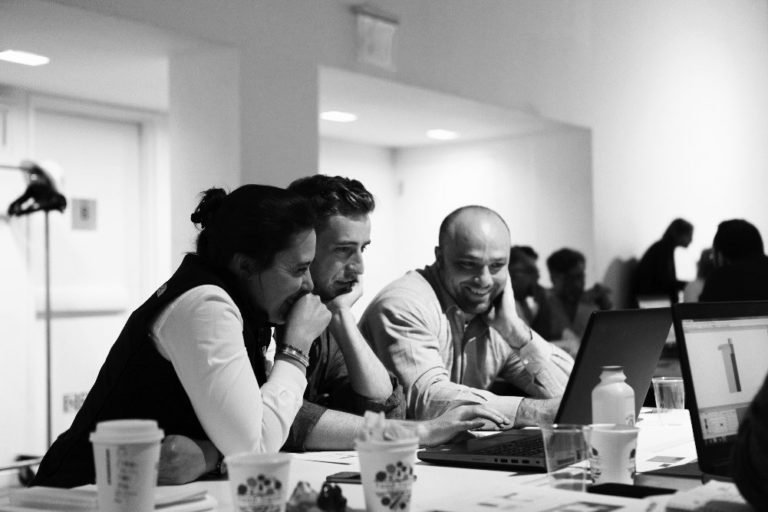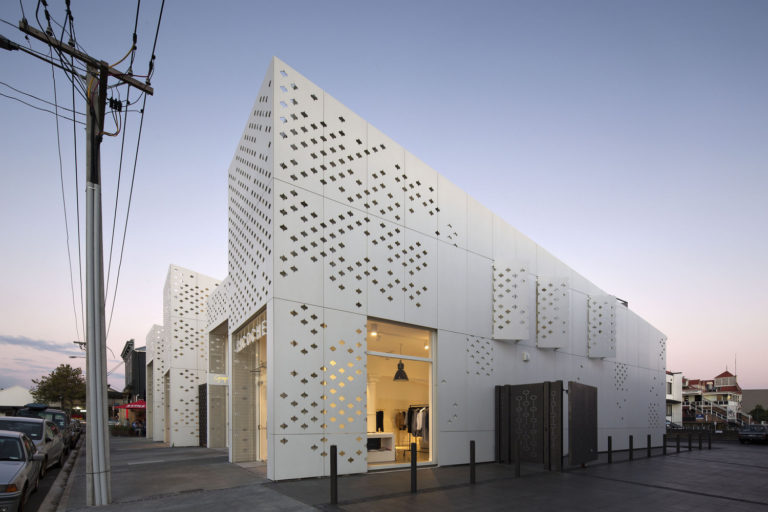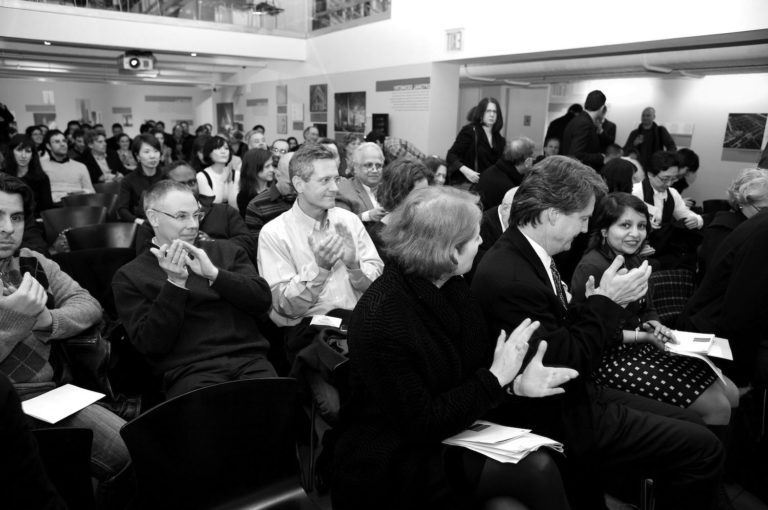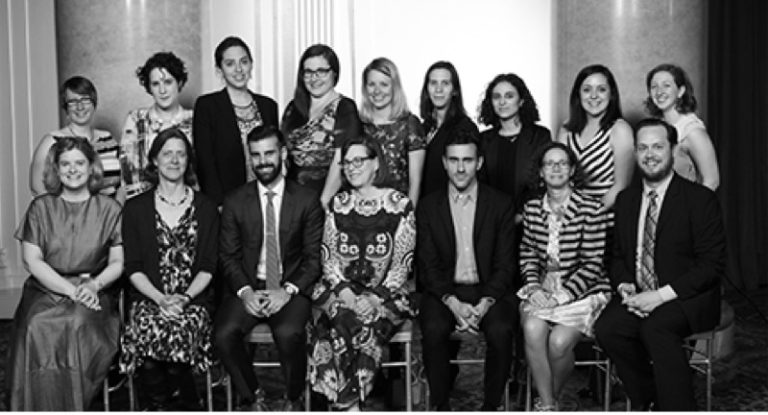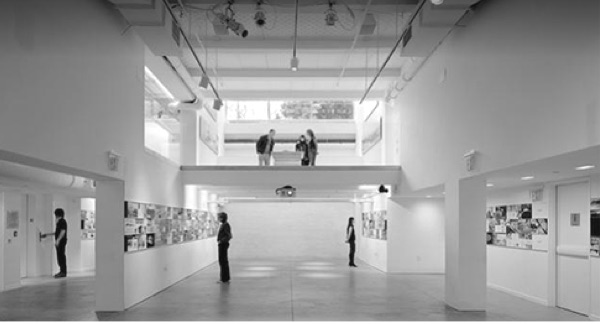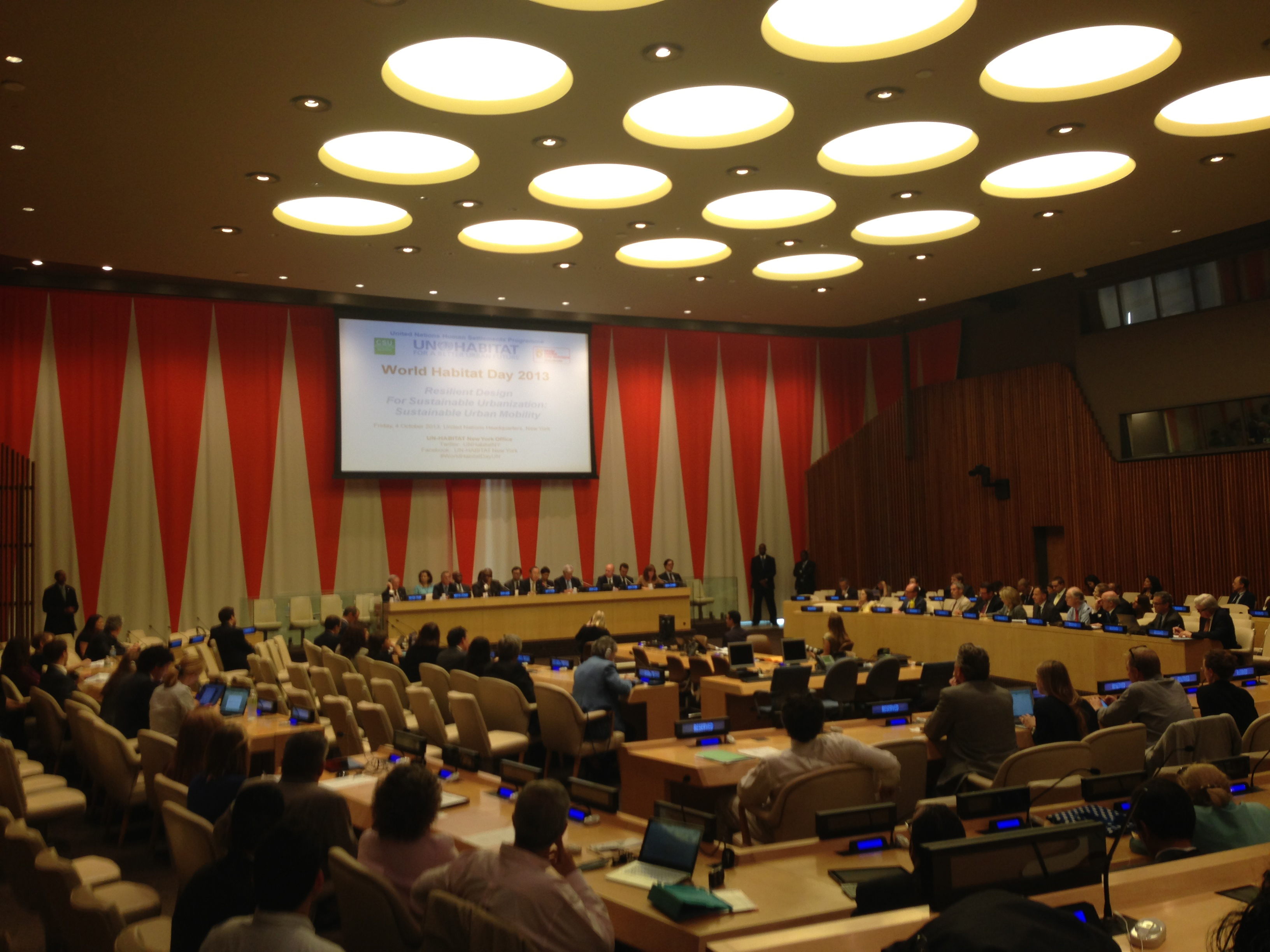by: Bill Millard
No one attending the United Nations conference for World Habitat Day needed convincing about certain key principles: that climate change and extreme weather events are accelerating; that these conditions challenge the sustainability of the world’s cities; and that decisions about whether, where, and how to build deserve the attention of every global citizen, not just that of architects and planners. One of the strengths of these UN-Habitat meetings is that broad acceptance of these fundamentals removes the need to debate the obvious and reinvent the wheel. (That certain powerful social elements do reject the obvious was manifest here only in a negative sense: with federal functions shut down by a faction in the House of Representatives, Housing and Urban Development Secretary Shaun Donovan, Hon. AIANY, had to cancel his appearance.) Inside the chamber, the rhetorical tone could be ceremonial or exhortatory, but the panelists wasted no time on drama, adversariality, or grandstanding, proceeding instead to consider relevant experience and practical disaster-mitigation strategies.
Secretary-General Ban Ki-moon’s welcoming remarks established linkages between sprawl reduction, flood protection, sustainable farming, greenhouse-gas-emission mitigation, traffic-congestion control, and quality-of-life improvement amid the accelerating urbanization of the world population. These measures are particularly urgent in developing countries, where investment to counteract “transport poverty” may take either adaptive or maladaptive forms, inclusive or exclusionary ones. “Getting mobility right,” he noted, “can mean the difference between a struggling city and a thriving one.” Transportation is not the only variable that determines resilience – as General Assembly President John Ashe and others went on to emphasize, disaster planning is inherently multidisciplinary – but it is a pivotal one. Buro Happold’s Craig Schwitter later paraphrased economist Jeffrey Sachs on how the world’s economies have organized efficiently around fossil fuels, with one slight caveat, “that they’re killing us”. Without pretending to have silver-bullet solutions, Schwitter called for integrated thinking about protecting transit and energy infrastructure not through fortress-building but through layered systems in a “living city” (microgrids, alternative transport, cogeneration plants, “parks as unsung heroes in a resiliency battle”), and through attention to the long-neglected externalities in energy economics.
Some of the most useful discussions involved the experiences of cities and nations that have endured the climate’s wrath. Some are familiar: the Netherlands’ response to severe events, for example, particularly the 1953 flood, makes Dutch infrastructural and organizational expertise indispensable to low-lying cities elsewhere. Netherlands’ Senior Advisor, Hurricane Sandy Rebuilding Task Force Henk Ovink commented on the rising frequency of high-risk climatic events, the determination of President Obama (“a president who gets it”) and Secretary Donovan to take action through initiatives like the post-Hurricane Sandy competition Rebuild by Design, and the key cultural element in both preventive standards implementation and post-disaster recovery. This theme that would recur in Ovink’s more detailed afternoon presentation, highlighting practical collective action over “engineering your way out of a disaster” through coastline-shortening or barrier construction. Barcelona, too, represented by Mayor Xavier Trias, stands as a world-renowned example of sound planning, balancing knowledge-centered economic development with sane social services. Though it is not as exposed to meteorologic disasters as other cities, Trias observed, it will share its knowledge on sustainability and hydrology by hosting the Global Water Operators’ Partnerships Alliance.
More surprising testimony came from Hoboken, NJ, which absorbed some of Sandy’s worst effects – when its Port Authority Trans-Hudson (PATH) station flooded, along with half of the city’s land, some 30,000 commuters had to find alternative transportation overnight – and became a case study in damage mitigation. Mayor Dawn Zimmer pointed out that the small city’s combination of high density and diverse multimodal transportation created a level of resilience that other cities can learn from. With light rail, buses, the Holland and Lincoln tunnels, extensive bicycle facilities (including a dockless share system, Social Bicycles), car sharing, and a walkable proximity to additional infrastructure in Jersey City, Hobokenites had multiple options when the PATH system became unavailable. “Let me be clear,” Zimmer cautioned, “at the time, nobody thought the system was working well; for months, it was an enormous challenge… but in hindsight, we can see that the system was surprisingly resilient.”
This redundancy principle, as later discussions would explore, is a key part of the distinctions along a continuum from sustainability to resilience to regeneration. In the afternoon session’s audience-questioning segment, Nancy Kete of the Rockefeller Foundation explained to an inquisitive and articulate schoolchild that sustainable design, often framed as a matter of efficiency or “doing more with less,” sometimes removes the extra resources that allow a system to absorb shocks. AIANY President-elect Lance Jay Brown, FAIA, offered another useful case study: Greensburg, Kansas, which was destroyed by a 2007 tornado but bounced back as a purposeful community, using its democratic mechanisms (“their first contested election in 40 years”) to implement a green-construction law and become the nation’s first city to require LEED Platinum standards in all new city buildings. The cultural and political aspects of urban resilience, numerous panelists stressed, are at least as important as design and engineering variables in determining which communities reinvent themselves after disasters and which ones languish.
NJIT Architecture Dean Urs Gauchat, Hon. AIA, brought sobering choices into focus while guiding the morning discussion to consider the values implicit in adaptation, managed retreat from flood-risk zones, and choices about protecting lives or property. “Without the political will and the concomitant resources,” he said, “it will not be possible to do what is effective and wise. There is always a temptation to return to a status quo ante, without taking steps to increase the resistance to future onslaughts.” Consultant Laurie Johnson contrasted the buyout, relocation, and rebuilding policies in several disaster-struck cities, from wealthy Portola Valley, CA, to New Orleans, already declining when Katrina struck. BuildingGreen founder Alex Wilson examined primary and secondary effects of sea-level rise (if the waters don’t get you, the power blackouts will), and offered a no-nonsense series of resilient-design principles (e.g., it transcends scales, exists in degrees rather than as an absolute, and raises the demand for renewable, reclaimed, locally available, and/or natural materials). AIANY’s Rick Bell, FAIA, called attention to the Design for Risk and Reconstruction Committee’s work on urban floodproofing, retrofitting, and code/zoning changes. Federal Alliance for Safe Homes President and CEO Leslie Chapman-Henderson highlighted seismic safe-building efforts in Florida, Memphis, and elsewhere, noting that media reporting during disasters is often highly unreliable (and inspiring an audience member to lament the endless series of “talking heads doing the windblown-parka thing”).
The passion for building cities, Chair and UN-Habitat Executive Director Jean Clos noted in summation, was one of two defining human characteristics that Sophocles observed in a much earlier state of social organization, the other being language. Certainly the two are intertwined. Only a few million people lived in cities when Sophocles was writing; with some 3.5 billion in today’s urban population (in the process of doubling), Clos continued, the imperative to minimize risks and mitigate our consumption path can keep our urbanizing passion from accelerating into an “uncontrollable future. We are dominating planet Earth, perhaps in a not-very-wise manner.” We also know, in useful detail, which habits of ours are unsustainable. We don’t yet have a consensus on corrective actions to match that diagnostic consensus; still, Clos concluded, gatherings and communications like this one show how quickly and thoroughly we can learn from crises.
Bill Millard is a freelance writer and editor whose work has appeared in Oculus, Icon, The Architect’s Newspaper, and other publications.
Event: Resilient Design for Sustainable Urbanization: Sustainable Urban Mobility (World Habitat Day 2013)
Location: United Nations Headquarters, Economic and Social Council Chamber, 10.04. 13
Speakers: Dr. Joan Clos, Under-Secretary-General and Executive Director, UN-Habitat (chair); Ban Ki-moon, Secretary General, United Nations; John Ashe, President-elect of the UN General Assembly; Nestor Osorio, Permanent Representative of Colombia to the United Nations and President, UN Economic and Social Council; Henk Ovink, Netherlands’ Senior Advisor, Hurricane Sandy Rebuilding Task Force and former Director General for Spatial Planning and Water Affairs, The Netherlands (keynote); Melanie Schultz-van Haegen, Minister of Infrastructure and Environment, The Netherlands; Dawn Zimmer, Mayor of Hoboken, N.J.; Xavier Trias, Mayor of Barcelona; Daniel Zarilli, NYC Director of Resiliency; Dr. A. K. Abdul Momen, Ambassador, Permanent Representative of the People’s Republic of Bangladesh to the UN (chair, morning discussion, “Resilient Design – To Build or Not To Build?”); Prof. Urs Gauchat, Hon. AIA, Dean, College of Architecture and Design, New Jersey Institute of Technology (NJIT) (moderator); Laurie Johnson, Johnson Consulting and Research; Alex Wilson, Founder and Executive Director, BuildingGreen; Rick Bell, FAIA, Executive Director, AIA New Uork Chapter; Leslie Chapman-Henderson, President and CEO, Federal Alliance for Safe Homes; Jill N. Lerner, FAIA, 2013 President, AIANY; Thomas G. Dallessio, AICP/PP, Director, Center for Resilient Design, NJIT; Neo Ek Beng Mark, Deputy Permanent Representative of Singapore to the UN and Co–Chair, Friends of Sustainable Cities (chair, afternoon discussion, “Resilient Design for Sustainable Urbanization”); Prof. Lance Jay Brown, FAIA, ACSA Distinguished Professor, Spitzer School of Architecture, City College of New York, and President-elect, AIANY (moderator); Nancy Kete, Ph.D., Managing Director, Rockefeller Foundation; Fiona Cousins, Principal, Arup New York; Craig Schwitter, Principal, Buro Happold, New York; Harini Nagendra, Cities and Biodiversity Outlook; James McCullar, FAIA, Co-chair, Consortium for Sustainable Urbanization, James McCullar Architecture, and AIANY Past President,; Aliye Pekin Celik, Ph.D., Co-chair, Consortium for Sustainable Urbanization, United Cities and Local Governments, NY; Yamina Djacta, Director, UN-Habitat, NY Office; Beatriz Muñozcano, UN-Habitat Youth Representative
Organizers: UN-Habitat; Consortium for Sustainable Urbanization; Center for Resilient Design, New Jersey Institute of Technology; AIANY

